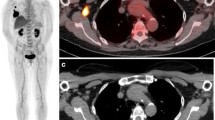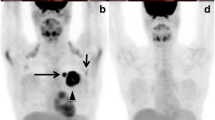Abstract
PET or PET/CT mostly utilizing the tracer [18F]fluorodeoxyglucose (18FDG) are unique imaging methods for the detection of breast cancers with increased glucolytic activity. PET/CT simultaneously provides anatomic and metabolic information by detecting increased glucose uptake. PET/CT may provide extra information on stage that can be utilized in certain cases during treatment decision making. PET/CT is a very sensitive imaging option to detect lymph node involvement or distant metastasis for which information is needed in selected cases. In the neoadjuvant or metastatic setting, PET or PET/CT may serve as a valuable noninvasive option for investigating chemosensitivity and monitoring the effectiveness of systemic therapy. Its use, however, should be reserved for particular cases with diagnostic uncertainty in the routine management of breast cancer.
Molecular imaging with non-FDG PET tracers developed using advanced molecular and cell biology techniques widens the possibility to study the pathological molecular events and processes in breast cancer, and may be used for the detection of key molecules to be targeted by pharmaceutical interventions; the method provides new possibility to evaluate novel drugs.
Similar content being viewed by others
References
Makhoul I, Kiwan E. Neoadjuvant systemic treatment of breast cancer. J Surg Oncol. 2011 Mar 15;103(4):348–57.
Robertson IJ, Hard F, Kell MR. FDG-PET/CT in the staging of local/regional metastases in breast cancer. Breast. 2011 Jul 30. Epub ahead of print.
Monzawa S, Adachi S, Suzuki K, et al. Diagnostic performance of fluorodeoxyglucose-positron emission tomography/computed tomography of breast cancer in detecting axillary lymph node metastases: comparison with ultrasonography and contrast-enhanced CT. Ann Nucl MED. 2009;23(10):855–61.
Ueda S, Tsuda H, Asakawa H, et al. Utility of 18F-fluoro-deoxyglucose emission tomography/computed tomography fusion imaging (18F-FDG PET/CT) in combination with ultrasonography for axillary staging in primary breast cancer. BMC Cancer. 2008;8:165
Fuster D, Duch J, Paredes P, et al. Preoperative staging of large primary breast cancer with [18F]fluorodeoxyglucose positron emission tomography/computed tomography compared with conventional imaging procedures. J Clin Oncol. 2008;26:4746–51.
Carkaci S, Macapinlac HA, Cristofanilli M, et al. Retrospective study of 18F-FDG PET/CT in the diagnosis of inflammatory breast cancer: preliminary data. J Nucl Med. 2009;50(2):231–8.
Alberini JL, Lerebours F, Wartski M, et al. 18F-fluorodeoxyglucose positron emission tomography/computed tomography (FDG-PET/CT) imaging in the staging and prognosis of inflammatory breast cancer. Cancer. 2009 Nov 1;115(21):5038–47.
Groheux D, Moretti JL, Baillet G, et al. Effect of (18)F-FDG PET/CT imaging in patients with clinical Stage II and III breast cancer. Int J Radiat Oncol Biol Phys. 2008 Jul 1;71(3):695–704.
Groheux D, Giacchetti S, Espié M, et al. The yield of 18F-FDG PET/CT in patients with clinical stage IIA, IIB, or IIIA breast cancer: a prospective study. J Nucl Med. 2011;52:1526–34.
Koolen BB, Vegt E, Rutgers EJ, Vogel WV, et al. FDG-avid sclerotic bone metastases in breast cancer patients: a PET/CT case series. Ann Nucl Med. 2011 Sept 28. Epub ahead of print.
Hahn S, Heusner T, Kümmel S, et al. Comparison of FDG-PET/CT and bone scintigraphy for detection of bone metastases in breast cancer. Acta Radiol. 2011 Nov 1;52(9):1009–14.
Niikiura N, Costelloe CM, Madewell JE, et al. FDG-PET/CT compered with conventional imaging in the detection of distant metastases of primary breast cancer. Oncologist. 2011;16(8):1111–9.
Ohsumi S, Inoue T, Kiyoto S, et al. Detection of isolated ipsilateral regional lymph node recurrences by F18-fluorodeoxyglucose positron emission tomography-CT in follow up of postoperatve brast cancer patients. Breast Cancer Res Treat. 2011. Epub ahead of print.
Ueda S, Tsuda H, Asakawa H, et al. Clinicopathological and prognostic relevance of uptake level using 18F-fluorodeoxyglucose positron emission tomography/computed tomography fusion imaging (18F-FDG-PET/CT) in primary breast cancer. J Clin Oncol. 2008;38(4):250–8.
Ueda S, Tsuda H, Saeki T, et al. Early reduction in standardized uptake value after one cycle of neoadjuvant chemotherapy measured by sequential FDG PET/CT is an independent predictor of pathological response of primary breast cancer. Breast J. 2010;16(6):660–2.
Ueda S, Tsuda H, Saeki T, et al. Early metabolic response to neoadjuvant letrozole, measured by FDG PET/CT, is correlated with a decrease in the Ki67 labeling index in patients with hormone receptor-positive primary breast cancer: a pilot study. Breast Cancer. 2011;18(4):299–308.
Wang CL, MacDonald LR, Rogers JV, et al. Positron emission mammography: correlation of estrogen receptor, progesterone receptor, and human epidermal growth factor receptor 2 status and 18F-FDG. AJR Am J Roentgenol. 2011;197(2):W247–55.
Ueda S, Saeki T, Shigekawa T, et al. (18)F-Fluorodeoxyglucose positron emission tomography optimizes neoadjuvant chemotherapy for primary breast cancer to achieve pathological complete response. Int J Clin Oncol. 2011 Aug 10. Epub ahead of print.
Keam B, Im SA, Koh Y, et al. Early metabolic response using FDG PET/CT and molecular phenotypes of breast cancer treated with neoadjuvant chemotherapy. BMC Cancer. 2011 Oct 20;11:452.
Kumar A, Kumar R, Seenu V, et al. The role of (18)F-FDG PET/CT in evaluation of early response to neoadjuvant chemotherapy in patients with locally advanced breast cancer. Eur Radiol. 2009;19:1347–57.
Berriolo-Riedinger A, Touzery C, Riedinger JM, et al. [18F]FDG-PET predicts complete pathological response of breast cancer to neoadjuvant chemotherapy. Eur J Nucl Med Mol Imaging. 2007,34:1915–24.
Duch J, Fuster D, Munoz M, et al. (18)F-FDG PET/CT for early prediction of response to neoadjuvant chemotherapy in breast cancer. Eur J Nucl Med Mol Imaging. 2009;36:1551–7.
Dunnwald LK, Gralow JR, Ellis GK, et al. Tumor metabolism and blood flow changes by positron emission tomography: relation to survival in patients treated with neoadjuvant chemotherapy for locally advanced breast cancer. J Clin Oncol. 2008;26:4449–57.
Jung SY, Kim SK, Nam BH, et al. Prognostic impact of [(18)F] FDG-PET in operable breast cancer treated with neoadjuvant chemotherapy. Ann Surg Oncol. 2009;17:247–53.
Rousseau C, Devillers A, Sagan C, et al. Monitoring of early response to neoadjuvant chemotherapy in stage ii and iii breast cancer by [18F]fluorodeoxyglucose positron emission tomography. J Clin Oncol. 2006;24:5366–72.
Schwarz-Dose J, Untch M, Tiling R, et al. Monitoring primary systemic therapy of large and locally advanced breast cancer by using sequential positron emission tomography imaging with [18F]fluorodeoxyglucose. J Clin Oncol. 2009;27:535–41.
Padmanabhan P, Goggi J, Bejot R, et al. Molecular targeting of breast cancer: imaging and therapy. Curr Pharm Biotechnol. 2011;12(4):528–38.
Sekar TV, Dhanabalan A, Paulmurugan R, et al. Imaging cellular receptors in breast cancers: an overview. Curr Pharm Biotechnol. 2011;12(4):508–27.
Tomasi G, Kenny L, Mauri F, et al. Quantification of receptor-ligand binding with [(18)F]fluciclatide in metastatic breast cancer patients. Eur J Nucl Med Mol Imaging. 2011;38(12):2186–97.
Hatt M, Cheze-Le Rest C, Aboagye EO, et al. Reproducibility of 18F-FDG and 3′-deoxy-3′-18F-fluorothymidine PET tumor volume measurements. J Nucl Med. 2010;51(9):1368–76.
Krause BJ, Schwarzenböck S, Schwaiger M. Tracers in oncology—preclinical and clinical evaluation. Nuklearmedizin. 2010;49(Suppl 1):S41–5.
Nanni C, Fantini L, Nicolini S, Fanti S. Non FDG PET. Clin Radiol. 2010;65(7):536–48.
Contractor KB, Kenny LM, Stebbing J, et al. [11C]choline positron emission tomography in estrogen receptor-positive breast cancer. Clin Cancer Res. 2009 Sept 1;15(17):5503–10.
Contractor KB, Kenny LM, Stebbing J, et al. Biological basis of (11C)choline-positron emission tomography in patients with breastcancer: comparison with (18F)fluorothymidine positron emission tomography. Nucl Med Commun. 2011;32(11):997–1004.
Oude Munnink TH, Nagengast WB, Brouwers AH, et al. Molecular imaging of breast cancer. Breast. 2009;18(Suppl 3):S66–73.
Linden HM, Kurland BF, Peterson LM, et al. Fluoroestradiol positron emission tomography reveals differences in pharmacodynamics of aromatase inhibitors, tamoxifen, and fulvestrant in patients with metastatic breast cancer. Clin Cancer Res. 2011 Jul 15;17(14):4799–805.
Kurland BF, Peterson LM, Lee JH, et al. Between-patient and within-patient (site-to-site) variability in estrogen receptor binding, measured in vivo by 18F-fluoroestradiol PET. J Nucl Med. 2011;52(10):1541–9.
Tinianow JN, Gill HS, Ogasawara A, et al. Site-specifically 89Zr-labeled monoclonal antibodies for ImmunoPET. Nucl Med Biol. 2010;37(3):289–97.
Dijkers EC, Oude Munnink TH, Kosterink JG, et al. Biodistribution of 89Zr-trastuzumab and PET imaging of HER2-positive lesions in patients with metastaticbreast cancer. Clin Pharmacol Ther. 2010;87(5):586–92.
Manning K, Tepfer B, Goldklang G, et al. Clinical practice guidelines for the utilization of positron emission tomography/computed tomography imaging in selected oncologic applications: suggestions from a provider group. Mol Imaging Biol. 2007;9(6):324–32.
Conflict of interest
The authors declare that there is no actual or potential conflict of interest in relation to this article.
Author information
Authors and Affiliations
Corresponding author
Rights and permissions
About this article
Cite this article
Lőcsei, Z., Hideghéty, K. & Kahán, Z. The role of Positron Emission Tomography/Computer Tomography (PET/CT) in the diagnosis, staging, characterization, and therapy of breast cancer. memo 5, 119–124 (2012). https://doi.org/10.1007/s12254-012-0007-2
Received:
Accepted:
Published:
Issue Date:
DOI: https://doi.org/10.1007/s12254-012-0007-2




